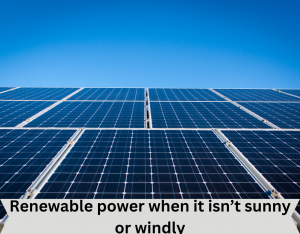ForumIAS announcing GS Foundation Program for UPSC CSE 2025-26 from 27th May. Click Here for more information.
Source: The post India’s renewable energy (RE) status has been created, based on the article “Renewable power, when it isn’t sunny or windy” published in “The Hindu” on 10th February 2024.
UPSC Syllabus Topic: GS paper3-infrastructure- Energy
News: The article discusses India’s efforts to increase its renewable energy capacity to 500 GW by 2030, focusing on solar and wind energy. Renewable power, when it isn’t sunny or windly
What is India’s renewable energy (RE) status?
India aims to achieve 500 GW of renewable energy by 2030.
So far, 72 GW of solar and 44 GW of wind energy have been installed.
Peak power demand is projected to grow from 240 GW in FY24 to 285 GW in FY28, with deficits of 10-15 GW, mainly in the evenings.
What challenges has India faced in achieving its renewable energy (RE) goals?
Energy Demand Fluctuations: The country faces fluctuations in demand across different seasons and times of the day, especially peaking in the evenings, requiring a more dynamic energy supply system.
Storage Capacity Constraints: Adequate storage solutions like batteries and pumped hydro are crucial but currently insufficient, impacting the ability to balance supply with varying demand.
Infrastructure Development Needs: Building sufficient infrastructure, including transmission systems, is essential to support the expanding renewable capacity.
Reliance on Long-Term PPAs: The reliance on 25-year power purchase agreements (PPAs) with state discoms is noted. These long-term agreements are crucial for financial stability in renewable projects but may limit flexibility in responding to changing market conditions.
Discoms’ Reluctance: Some reluctance from discoms to fully embrace ‘must run’ renewable energy. This hesitation can impact the seamless integration and consistent utilization of renewable energy sources into the national grid.
What initiatives has India taken for achieving its renewable energy (RE) goals?
Implementing ‘Must Run’ Status: Renewable energy projects, particularly solar and wind, have been accorded a ‘must run’ status, ensuring their continuous operation except in case of safety issues.
Supportive Government Policies: Introduction of favorable policies such as late payment surcharge waivers, inter-state transmission system charge waivers, and renewable purchase obligations to boost renewable energy growth.
Increased Competition and Foreign Investment: The renewable sector has seen a rise in competition among Independent Power Producers (IPPs) and an influx of foreign investments. This influx of competition and capital boosts innovation, leading to more efficient, cost-effective renewable energy solutions.
Development of Power Exchange Markets: India is developing power exchange markets to efficiently manage excess renewable energy. These markets enable the sale of surplus power, balancing supply and demand. This not only ensures grid stability but also enhances the financial viability of renewable energy projects.
Innovative Bidding Processes: Recent bids require renewable energy generators to match hourly demand, enhancing the reliability and comparability of renewable energy to traditional power sources. For instance, in the recent firm and dispatchable RE (FDRE) bids invited by SECI, generators are required to match round the clock (RTC) demand of discoms on a 15-minute basis.
Read More UPSC Topics-
What should be done?
Enhance Storage Capacities: Increase investment in storage solutions like batteries and pumped hydro to manage the intermittency of solar and wind energy.
Strengthen Grid Infrastructure: Develop robust grid infrastructure to support the increased load from renewable sources and ensure efficient energy distribution.
Promote Diverse Renewable Sources: Combine different renewable sources, like solar and wind, with storage to provide a more consistent energy supply.
Support Discoms in Transition: Assist discoms in integrating renewable energy into their systems, ensuring smoother adoption and operation.
Question for practice:
Discuss the challenges and initiatives India has faced and undertaken, respectively, in achieving its renewable energy goals.





